|
 |
|
|
|
|
|
|
|
|
|
|
|
|
|
|
|
|
|
 |
|
| Travel Destinations Guide |
|
|
| About Uttaranchal |
|
| |
|
| |
|
|
|
| Uttaranchal - Wildlife |
|
|
Uttarakhand is a wonderful tourist destination. Thousands of people go there every year to rejuvenate themselves amidst the mountains. The mountains in Uttarakhand are home to rare species of plants and animals which are protected by sanctuaries and reserves. The major sanctuaries and reserves of the area are Jim Corbett National Park, Valley of Flowers National Park, Govind National Park, Nanda Devi National Park, Rajaji National Park and Assan Barrage Bird Sanctuary.
The most common animals found in Uttarakhand are wild sheep, goat, oxen, antelopes and butterflies but rare and endangered animals such as Musk Deer, Snow Leopard, Ghorals and Monal are also found here.
Jim Corbett National Park is one of the most famous wildlife sanctuaries of Uttarakhand. Established by the British government as a reserve area to protect tigers, today one can observer them in their natural habitat.
The Nanda Devi National Park & Valley of Flowers have been named as a UNESCO World Heritage Site. Since the Valley of Flowers resembles Kashmir when in full bloom, it is worth giving a visit.
Both Rajaji National Park and Assan Barrage Bird Sanctuary are very close to Dehradun, the capital city of Uttarakhand. Though one cannot cover both of them in a day, one can certainly make Dehradun the base and then explore both the wonderful places, especially for a wildlife aficionado.
 Nanda Devi National Park Nanda Devi National Park
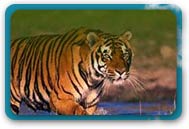 In the vicinity of Nanda Devi (7817 m), the second highest peak in India, is situated the Nanda Devi National Park, which has some of the most unique high altitude flora and fauna in the world. The spectacular views, sylvan environment, and richness of biosphere make it quite different from the other wildlife sanctuaries of India. The park has been declared a World Heritage Site by UNESCO and In its vicinity are the Valley of Flowers, Badrinath Temple, and Hemkund Sahib. Though the park was notified only in 1982, it has a long history. W.W. Garden was the first person to reach this region in 1883, but his expedition to the Nanda Devi Peak failed to create any impact. In 1936, Tilman and N.E. Odell scaled the Nanda Devi and opened its vista for others to follow. This led to the region becoming a game sanctuary in 1939. The area of the park remained undisturbed until 1950's when organized expeditions for Nanda Devi started. To save the park from these disturbances, the Government of India declared the region a National Park in 1982 and later it was given the special status of a Biosphere Reserve. In the vicinity of Nanda Devi (7817 m), the second highest peak in India, is situated the Nanda Devi National Park, which has some of the most unique high altitude flora and fauna in the world. The spectacular views, sylvan environment, and richness of biosphere make it quite different from the other wildlife sanctuaries of India. The park has been declared a World Heritage Site by UNESCO and In its vicinity are the Valley of Flowers, Badrinath Temple, and Hemkund Sahib. Though the park was notified only in 1982, it has a long history. W.W. Garden was the first person to reach this region in 1883, but his expedition to the Nanda Devi Peak failed to create any impact. In 1936, Tilman and N.E. Odell scaled the Nanda Devi and opened its vista for others to follow. This led to the region becoming a game sanctuary in 1939. The area of the park remained undisturbed until 1950's when organized expeditions for Nanda Devi started. To save the park from these disturbances, the Government of India declared the region a National Park in 1982 and later it was given the special status of a Biosphere Reserve.
 Askot Sanctuary Askot Sanctuary
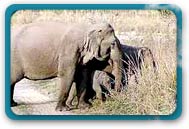 Askot sanctuary is situated at a distance of 54 km from Pithoragarh. Askot was the ancient kingdom of Katyur dynasty it also has a palace of the last Katyuri king. The name of Askot has been derived from the word Asi-kot, that is 80 forts. There are remains of the ancient forts all over the area. The area is rich for its sal, oak and pine forest and rich waterfalls. The important assets conserved here are `Malika Arjun temple` and the `Swami Narayan Ashram`. The Askot Sanctuary has charismatic hilly areas, and the houses surrounded by greenery, adds more amazement to its already splendid beauty. Askot is located in the lap of Kumaon Himalayas at a height of 1,650 metres, with the view of snow capped mountain peaks. The places of interest in the sanctuary are snow leopards, Himalayan black bears, musk deers, snow cocks, tahrs, bharals, monals, chirs, koklas, pheasants and chukors. Askot sanctuary is situated at a distance of 54 km from Pithoragarh. Askot was the ancient kingdom of Katyur dynasty it also has a palace of the last Katyuri king. The name of Askot has been derived from the word Asi-kot, that is 80 forts. There are remains of the ancient forts all over the area. The area is rich for its sal, oak and pine forest and rich waterfalls. The important assets conserved here are `Malika Arjun temple` and the `Swami Narayan Ashram`. The Askot Sanctuary has charismatic hilly areas, and the houses surrounded by greenery, adds more amazement to its already splendid beauty. Askot is located in the lap of Kumaon Himalayas at a height of 1,650 metres, with the view of snow capped mountain peaks. The places of interest in the sanctuary are snow leopards, Himalayan black bears, musk deers, snow cocks, tahrs, bharals, monals, chirs, koklas, pheasants and chukors.
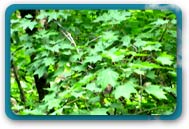  Binsar Sanctuary Binsar Sanctuary
Perched at an elevation of 2,412mts above sea level, Binsar is situated amidst Binsar Wildlife Sanctuary. Binsar is an ideal destination for writers, nature lovers and adventure lovers. The dense Binsar Wildlife Sanctuary is the home of 200 bird species, Barking Deer, Himalayan bear, leapord, fox, musk deer, langur, porcupine, flying squirrel, chital, jungle cat etc.
he views of major peaks like Chaukhamba, Panchachuli, Nanda Devi, Nanda Kot, and Kedarnath are distinctly visible from here. There are limited number of hotels in Binsar so do make prior bookings before visiting. If you are a die-hard nature lover then prepare yourself to add Binsar in your must see places. It is an ideal place for Bird watching and wildlife photography. An entry ticket of Rs. 40 per person and Rs. 50 for a car has to be paid at the entry point of Binsar. Electricity is limited in Binsar region so as to prevent the natural beauty.
Chand Kings, who ruled over Kumaon, from 11th to 18th centuries AD enjoyed their summers at Binsar. Binsar offers salubrious climate throughout the year. During monsoons Binsar offers varied greenery and it receives snowfall during winters. Take woolens with you while planning a trip to Binsar. There are several popular excursions in the proximity of Binsar. Enjoy peaceful and serene walks in Binsar enjoying the unmatched beauteousness of nature. Binsar is situated in Kumaon region of Uttarakhand state and it is well connected by motorable roads. The main attraction of Binsar is the majestic view of the Himalayan peaks situated 300kms away.
 Rajaji National Park Rajaji National Park
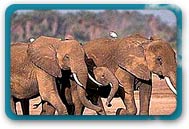 Rajaji National Park was established in 1983 amidst the bio diverse area of the Shivalik Hill range on the Himalayan foothills. The national park's name has been dedicated to C. Rajagopalachari, fondly known as Raja Ji. He was a prominent freedom fighter, the 1954 recipient of Bharat Ratna and the second and last Governor-General of Independent India. The reserve is spread over 820.42 square kms, covering almost three districts of Uttaranchal (Haridwar, Dehradun and Pauri Garhwal). The park has 10 comfortable guest houses and visitors are allowed to cook their own food. Rajaji National Park was established in 1983 amidst the bio diverse area of the Shivalik Hill range on the Himalayan foothills. The national park's name has been dedicated to C. Rajagopalachari, fondly known as Raja Ji. He was a prominent freedom fighter, the 1954 recipient of Bharat Ratna and the second and last Governor-General of Independent India. The reserve is spread over 820.42 square kms, covering almost three districts of Uttaranchal (Haridwar, Dehradun and Pauri Garhwal). The park has 10 comfortable guest houses and visitors are allowed to cook their own food.
  Land of the Roar, Trumpet and Song Land of the Roar, Trumpet and Song
Jim Corbett Park is home to the thunderous tiger, trumpeting elephant and the twittering birds. The park has earned the name of "Land of Roar, Trumpet and Song". The Park is situated in the foothills of Uttaranchal gifting a sight of extraordinary beauty. It is the Patlidun, a broad flat valley, where the shining, rushing water of the river Ramganga wander through the hills andvalleys. Nature has spared no efforts against the green and coppery plants of the forest of Sal. The spread of the glowing red flowers and the glow of the Forest, the delicate hangings of ferns and creepers and the waving tiger grass produces an unforgettable scene of magnificence, while .the colourful birds, lost in otherworldly song, add to the charm of Jim Corbett Park. Although the Sal timber is droped and extracted in certain parts, the natural beauty of the area has remained undamaged. The Park is particularly attractive, when the flowering trees are in bloom.
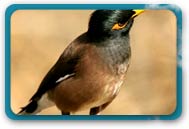
 Govind National Park Govind National Park
Govind National Park, also known as Govind Pashu Vihar, was established to save the increasingly endangered species. This sanctuary is spread over an area of 957.969 sq. kms with a varying altitude of 1,300 m to 6,323 m. River Tons enriches the entire area with its sediments and helps the vegetation in the sanctuary to grow uninhibited. This area is extremely rich in medicinal plants and is much sought after by Ayurvedic doctors. The sanctuary is also home to the now elusive and extremely endangered Snow Leopard that stays at 3,500 m.
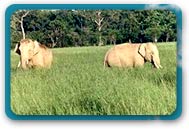
 Gangotri National Park Gangotri National Park
The Gangotri National Park is typical of high altitude ecosystems, with decisive influence from Trans Himalayan elements in both physical and biological characteristics. The landscape is dominated by alpine scrub, although forests of kharsu oak and betula are observed in patches in lower and higher elevation areas respectively. The mountain sides along the entire route from Gangotri to Gaumukh are steeper and are distinctly broken up by consequential landslides. These landslides appear to have caused irreversible isolation between forest patches including the alpine vegetation. The impact of these natural events on the forest and the dependent organisms is important to document, so as to assess the long-term value of this park in the wildlife perspective. The ground vegetation, although drying, is suggestive of high ground biomass in this area, and the recorded ground vegetative cover ranges from 10 to 50% (average = 25%).
|
|
|
|
|
|
|
|
|
|
|
|
|
|
|
